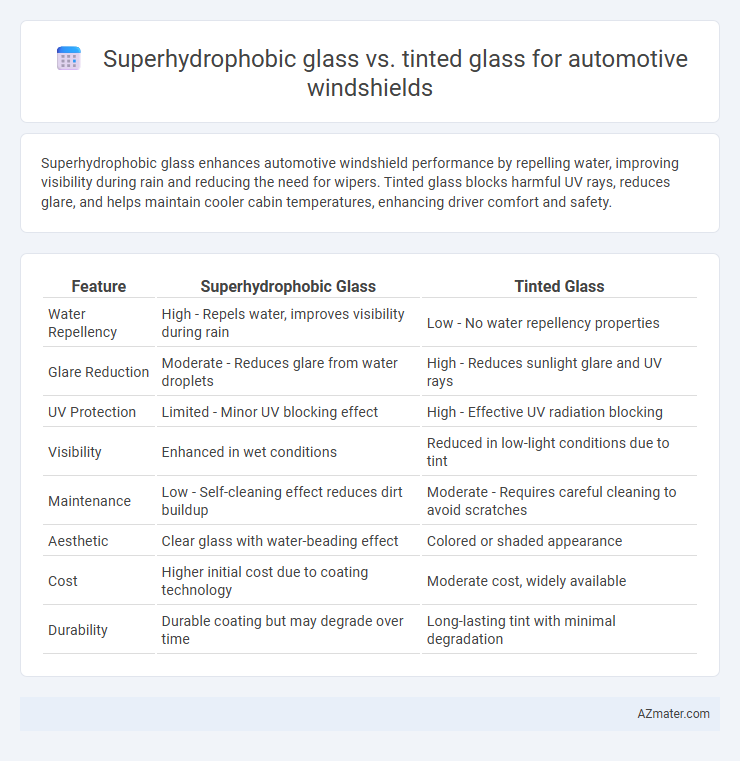Superhydrophobic glass enhances automotive windshield performance by repelling water, improving visibility during rain and reducing the need for wipers. Tinted glass blocks harmful UV rays, reduces glare, and helps maintain cooler cabin temperatures, enhancing driver comfort and safety.
Table of Comparison
| Feature | Superhydrophobic Glass | Tinted Glass |
|---|---|---|
| Water Repellency | High - Repels water, improves visibility during rain | Low - No water repellency properties |
| Glare Reduction | Moderate - Reduces glare from water droplets | High - Reduces sunlight glare and UV rays |
| UV Protection | Limited - Minor UV blocking effect | High - Effective UV radiation blocking |
| Visibility | Enhanced in wet conditions | Reduced in low-light conditions due to tint |
| Maintenance | Low - Self-cleaning effect reduces dirt buildup | Moderate - Requires careful cleaning to avoid scratches |
| Aesthetic | Clear glass with water-beading effect | Colored or shaded appearance |
| Cost | Higher initial cost due to coating technology | Moderate cost, widely available |
| Durability | Durable coating but may degrade over time | Long-lasting tint with minimal degradation |
Introduction to Automotive Windshield Technologies
Superhydrophobic glass repels water and reduces fogging, enhancing visibility and safety during wet conditions by creating a self-cleaning surface. Tinted glass minimizes glare and heat penetration, improving driver comfort and reducing UV exposure inside the vehicle. Both technologies advance automotive windshield performance through different functional enhancements tailored for safety and comfort.
What is Superhydrophobic Glass?
Superhydrophobic glass is engineered with a microscopic textured coating that repels water, causing droplets to bead and roll off the surface, enhancing visibility during rain without the need for wipers. This advanced technology improves safety by reducing water accumulation and glare, making it ideal for automotive windshields in wet conditions. Unlike tinted glass, which primarily reduces glare and UV exposure through embedded dyes or films, superhydrophobic glass actively minimizes water obstruction for clearer vision.
What is Tinted Glass?
Tinted glass in automotive windshields is specially treated to reduce glare, block ultraviolet (UV) rays, and improve privacy while maintaining visibility for the driver. It is made by adding a colored film or incorporating metal oxides during manufacturing, which can also help in reducing heat inside the vehicle. Compared to superhydrophobic glass, which repels water to enhance visibility during rain, tinted glass primarily focuses on controlling light transmission and thermal comfort.
Key Differences: Superhydrophobic vs. Tinted Glass
Superhydrophobic glass features a nano-coated surface that repels water, enhancing visibility during rainy conditions by preventing water droplets from adhering to the windshield. Tinted glass primarily reduces glare and blocks ultraviolet (UV) rays, improving driver comfort and protecting interior materials from sun damage. While superhydrophobic glass improves safety by maintaining a clearer view in wet weather, tinted glass focuses on heat reduction and UV protection without altering water repellency.
Performance in Weather Conditions
Superhydrophobic glass significantly enhances visibility during rainy conditions by causing water droplets to bead and roll off quickly, reducing the need for windshield wipers and improving safety. Tinted glass primarily reduces glare and heat from sunlight, offering comfort during sunny weather but providing limited advantage in rainy or foggy conditions. In extreme weather scenarios, superhydrophobic coatings outperform tinted glass by maintaining clearer vision and minimizing water accumulation on the windshield.
UV Protection and Heat Management
Superhydrophobic glass for automotive windshields excels in repelling water and dirt, enhancing visibility while often incorporating UV-blocking coatings that reduce harmful ultraviolet radiation exposure. Tinted glass provides effective heat management by absorbing and reflecting solar infrared radiation, thereby lowering cabin temperatures and improving comfort during sunny conditions. Combining UV protection and heat reduction, tinted glass typically offers superior heat management, whereas superhydrophobic coatings primarily contribute to better clarity and maintenance rather than thermal control.
Durability and Maintenance
Superhydrophobic glass offers enhanced durability by repelling water, dirt, and oils, significantly reducing the need for frequent cleaning and preventing long-term damage from contaminants. Tinted glass, while effective in reducing glare and UV exposure, does not inherently improve surface durability and may require specialized cleaning to avoid scratching or degrading the tint film. Maintenance for superhydrophobic glass is generally lower due to its self-cleaning properties, whereas tinted glass demands careful upkeep to preserve both clarity and tint integrity over time.
Safety and Visibility Considerations
Superhydrophobic glass enhances automotive windshield safety by repelling water and reducing the need for wipers, thus maintaining clear visibility during heavy rain and minimizing glare caused by water droplets. Tinted glass improves safety by reducing glare from direct sunlight and headlights, but excessive tinting can impair visibility in low-light conditions or at night. Choosing between superhydrophobic and tinted glass involves balancing improved wet-weather visibility against potential challenges in varied lighting environments for optimal driver safety.
Cost Comparison and Installation
Superhydrophobic glass generally incurs higher initial costs due to advanced nano-coating technology designed to repel water, whereas tinted glass remains more affordable with simpler manufacturing processes. Installation of superhydrophobic glass often requires specialized expertise to maintain coating integrity, leading to increased labor expenses compared to the more straightforward tint film application on standard windshields. Over time, the maintenance and potential re-application costs of superhydrophobic coatings can further elevate total expenditure relative to tinted glass, which typically demands minimal upkeep post-installation.
Which Windshield is Best for Your Vehicle?
Superhydrophobic glass offers superior water repellency, enhancing visibility during heavy rain by causing water to bead and roll off quickly, reducing the need for wipers and improving safety. Tinted glass blocks harmful UV rays, reduces glare, and helps maintain cooler cabin temperatures, contributing to passenger comfort and protecting interior materials from sun damage. Choosing the best windshield depends on your driving environment: superhydrophobic glass excels in wet climates, while tinted glass provides benefits in sunny, high-glare conditions.

Infographic: Superhydrophobic glass vs Tinted glass for Automotive windshield
 azmater.com
azmater.com